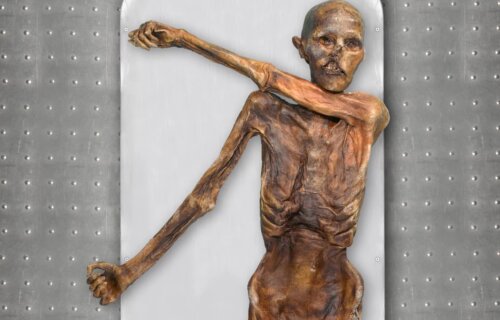LEIPZIG, Germany — Ötzi the Iceman, who lived around 5,300 years ago, was dark-skinned and bald, contrary to previous depictions, according to new research. Initial artists’ impressions of this early human portrayed him with light skin and long hair. However, a fresh analysis of Ötzi’s remains has revealed a different appearance, which includes signs of male pattern baldness.
The mummified body of Ötzi was discovered by German tourist Helmut Simon on a glacier in the Tirolean Ötztal Alps, on the Italian-Austrian border, on Sept. 19, 1991. Radiocarbon dating indicates that Ötzi lived around 3300 BC. He was a man between 25 and 35 years-old, standing approximately 5 feet 2 inches tall and weighing around 110 pounds.
Originally, it was believed that Ötzi had succumbed to exposure or exhaustion while crossing the Alps, freezing to death. However, a 2001 X-ray examination revealed an arrowhead lodged in his left shoulder, suggesting that he likely bled to death instead.
Using state-of-the-art technology, researchers have now generated a higher-quality genome of Ötzi to delve deeper into his genetic history, yielding some surprising findings. Published in the journal Cell Genomic, the results show that Ötzi had dark skin, dark eyes, and a balding head.

Since the initial analysis, technology has advanced rapidly, allowing several more genomes of other prehistoric Europeans to be fully decoded. This progress has enabled comparisons between Ötzi’s genetic code and that of his contemporaries. The new data suggests that among the hundreds of early European people who lived at the same time as Ötzi and whose genomes are now available, his has more in common with early Anatolian farmers than with any of his European counterparts.
“The genome analysis revealed phenotypic traits such as high skin pigmentation, dark eye color, and male pattern baldness that are in stark contrast to the previous reconstructions that show a light skinned, light eyed, and quite hairy male,” says Johannes Krause from the Max Planck Institute for Evolutionary Anthropology in a media release. “The mummy itself, however, is dark and has no hair.”
The refined genome analysis suggests that Ötzi belonged to an isolated Alpine population with limited gene flow from hunter-gatherer groups. Past studies had indicated a close genetic affinity between Ötzi and present-day Sardinians. However, these conclusions were reached before more human genomes became available.
In the new study, researchers sequenced Ötzi’s genome again using more recent sequencing technologies, resulting in a higher-quality genome.
“The most surprising results were the presence of male-pattern-baldness-related alleles supporting the absence of hair observed on the actual mummy and the rather dark skin pigmentation that is also supported by the mummy,” says Dr. Albert Zink, an anthropologist, study co-author, and head of the Eurac Research Institute for Mummy Studies in Italy.
“It is remarkable how the reconstruction is biased by our own preconception of a stone age human from Europe,” Krause adds.
Krause notes that over 92 percent of Ötzi’s ancestry traces back to early Anatolian farmers. This suggests that Ötzi’s population had limited gene exchange with people north and west of the Alps.
“We were very surprised to find no traces of Eastern European Steppe Herders in the most recent analysis of the Iceman genome; the proportion of hunter-gatherer genes in Ötzi’s genome is also very low. Genetically, his ancestors seem to have arrived directly from Anatolia without mixing with hunter gatherer groups,” explains Krause, head of the Department of Archaeogenetics at the Max Planck Institute for Evolutionary Anthropology in Leipzig, in a university release.
His skin type, already determined in the first genome analysis to be Mediterranean-European, was even darker than previously thought.
“It’s the darkest skin tone that has been recorded in contemporary European individuals,” explains Zink. “It was previously thought that the mummy’s skin had darkened during its preservation in the ice, but presumably what we see now is actually largely Ötzi’s original skin color. Knowing this, of course, is also important for the proper conservation of the mummy.”
Lastly, although genes associated with an increased risk of obesity and Type 2 diabetes were found in Ötzi’s genome, researchers believe these factors were likely mitigated by his active lifestyle.
Prof. Krause emphasized that it remains unclear whether Ötzi is representative of people from his time and region. Future studies, he suggests, should analyze more individuals from the same region and time period to answer this question conclusively.
You might also be interested in:
- ‘Dragon Man’ may replace Neanderthals as modern man’s closest relative
- Were our ancestors cannibals? Ancient bones reveal early humans ‘butchered one another’
- Discovery of 155 new genes reveals humans are still evolving!
South West News Service writer Stephen Beech contributed to this report.

